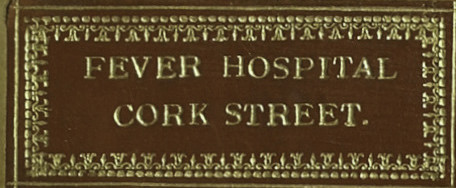The 1840’s were the period when famine again stalked the land. Unfortunately neither annual report nor minute book survive for the critical years 1847 to 1850.Though the numbers admitted were less than in the previous decade 33,801as against 45,451 the nature of the various outbreaks appears to be more serious. The latter part of the decade is notable for the eye witness accounts of the extent of disease and crowded hospitals.
1841 4329
1842-2872
1843 2375
1844 2529
1845 2863
1846 2954
1847 4555
1848 5875
1849 2472
1850 2977
As can be seen the admission figures after 1841 indicate a relatively peaceful period in the hospital’s and the capital’s history. The situation began to change however in 1846. Between July 1846 and August 1850 34,622 persons died in the temporary fever hospitals in Ireland. ( Report on the Commissioners of Health, Ireland, On the Epidemics, of 1846 to 1850, Appendix A, No 16, p68 )In Dublin alone at least one sixth of the population was treated for fever in the same period and the death toll was 4,364 of whom 1664 died of cholera. In 1847 as the number of admissions began to mount Cork Street hospital again erected tents in the grounds. Additional accommodation for two hundred patients was provided this way. Four wooden sheds were also built capable of holding two hundred and eighty patients. The government created a temporary hospital in Kilmainham with a capacity for almost a thousand people. Unlike earlier epidemics when the admission figures for the hospital reflected the city at large, on this occasion the hospital was just one of many providing relief. In the month of March 1847, the city’s hospitals treated 14,766 patients.( Cormac O’Grada , Black 47 and beyond, the great Irish famine in history, economy and memory(new jersey, 1999) p178) The Kilmainham hospital treated 6,878 cases between its opening in June 1847 and its closure in July 1848.On the 12th November 1847 there was 852 patients in this hospital.( Dr. Nalty, Report on fever, in Reports of the fever epidemic in Ireland available at http://www.institutions.org.uk/hospitals/ireland/ireland_fever_epidemic.htm )There are extraordinary accounts of the situation around the Kilmainham temporary hospital. One commentator referred to the heaps of fever stricken dead and dying waiting for admission. A Dr. Curran described a visit he made to the hospital and expressed his shock at the scenes he encountered. On the entrance to the hospital he saw twelve people, men, women and children lying in the pathway and in the gutter awaiting admission, their mouths open, and their black and parched tongues were visible from a distance. Some of the women had children at their breast that lay beside them in exhaustion. On entering one of the sheds housing patients he encountered thirty five people heaped together. They had been lying there for three days in a area too small to properly accommodate them, and exposed to the elements as the entrance was kept open due to the number of patients. Curran went on to mention that the government had ordered Cork Street hospital to close their tents, presumably on the basis that Kilmainham could handle the situation.( The Irish Board of Health, progress of fever, in The Lancet, 18th September 1847, p314 )This was disputed by the Dublin Evening Post which carried government correspondence on the matter. The correspondence, however, was ambivalent on the issue. Dr Curran was a young man who had refused employment in the government run fever hospitals on the grounds that the salary offered; five shilling per day was an insult to his profession. He was working apparently unpaid in a dispensary when these remarks were reported. The same issue of The Lancet that reported these remarks also carried notice of Dr. Curran’s death from typhus. He was twenty seven years of age. (The Lancet, September 1847 p367) The late 1840’s were the period when famine struck and there has always been a question mark over how it affected the capital. These figures indicate that Dublin also suffered during the famine period.
